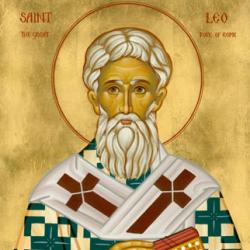Carlo Acutis – The Millennial Saint
In this 14 minute podcast, Dr. Italy discusses the inspiring life of the great f...

It is regrettable that so little is known about the early life of this man who proved to be such an extraordinary shepherd of the Catholic Church that he came to be known not only as Pope Saint Leo I, but also is one of the only two Popes in two thousand years to be called “the Great.”
What we do know about the life of St. Leo the Great is that, as a deacon of the Roman Church, before being elevated to the office of Pope in 440 AD, St. Leo the Great had opposed the heresy of Pelagianism. Pelagius had taught that grace was not necessary for salvation, but was rather a bonus that God granted to those who earned it by their good works.
As Pope, St. Leo the Great was forceful and unambiguous in his Christological teaching which affirmed the full divinity and humanity of Christ. In fact his most famous writing, commonly known as the Tome of St. Leo (449), was the basis of the Council of Chalcedon’s (451) dogmatic definition of Christ as one Divine Person possessing two complete natures, human and divine.
St. Leo the Great was Pope during the middle of the fifth century, a troubled time when barbarian armies were ravaging the once mighty Roman Empire. For all intents and purposes, the Western Empire was in total political and military collapse and there was a vacuum of political leadership. Pope St. Leo filled that void and became the advocate for the temporal as well as spiritual welfare of his flock. He is perhaps most famous for persuading Attila the Hun to abandon his plans to sack the city of Rome and to withdraw his forces beyond the Danube river (452). St. Leo once again was the spokesperson for the Roman citizenry in 455 when the Vandal barbarians swept into Central Italy, securing concessions from them.
Through both his powerful teaching and his leadership, Pope St. Leo the Great very much strengthened the office of the Papacy. He made a strong biblical case for the Divine institution of this ministry by examining the biblical evidence for Peter’s unique role among the apostles.
The writings that survive by St. Leo, besides his famous Tome, consist of 143 letters and 96 sermons. His sermons cover every season of the liturgical year and are a veritable treasure. They reveal to us a man with a clear and vigorous way of teaching the faith passed down from the apostles. St. Leo the Great, who died in 461, is regarded as one of the most important of the Western Fathers of the Church. He was declared a “Doctor of the Church” by Pope Benedict XIV. For more info on St. Leo the Great, see When the Church Was Young: Voices of the Early Fathers. Biography by Dr. Italy